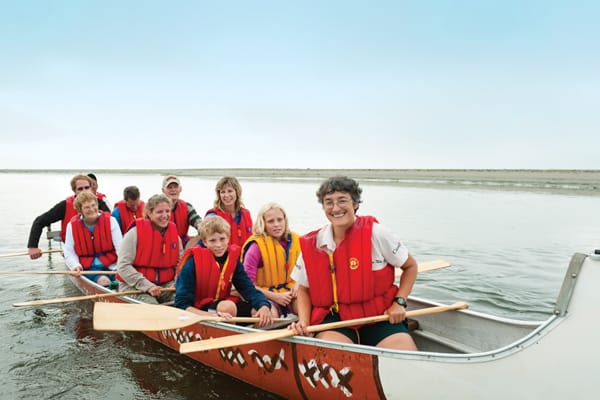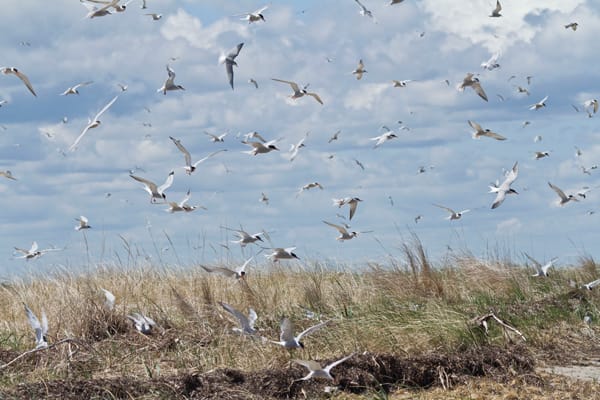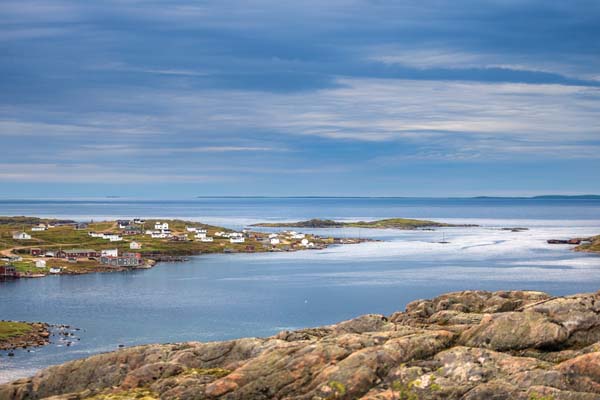New Brunswick’s Kouchibouguac National Park is a haven for those who love wildlife and water
The din is deafening. It emanates, in part, from Canada’s largest nesting colony of common terns; there are more than 25,000 squawking away here. Adding to that is the sound, from a nearby sandbar, of as many as 1,000 barking, splashing grey seals.
“That is the hotspot of the park,” says Victor Savoie, heritage presentation co-ordinator at Kouchibouguac National Park on New Brunswick’s eastern coast. He’s talking about a narrow channel of water called Blacklands Gully that cuts through a series of sandbars and dunes.

Savoie developed an excursion known as the Voyageur Canoe Adventure 18 years ago, so park visitors could travel safely with an interpreter and “stern person” to see the terns and seals. He still guides the tour himself. “This is no zoo. Blacklands Gully is an area you cannot visit by walking, bike or car,” he says. “You need a watercraft of some sort to get there.”
The replica voyageur canoe holds up to nine paddlers, depending on how many children are on board. Available in English and in French, from late June to the end of August, and open to anyone six years old and up, this three-hour adventure to the middle of the park’s 25 kilometres of shifting, sandy barrier islands is perfect for a family outing. (This year there are also plans for a limited number of tours in June and into September.)
The voyageur-style canoe launches within the park, from the private St-Louis Cape Wharf. Savoie delivers safety instructions, then navigates the canoe—powered by those eight or nine paddlers—through three aquatic habitats, starting with 20 minutes on the Kouchibouguacis River.
In the native Mi’kmaq tongue, Kouchibouguacis means “Little Sister of the Kouchibouguac.” Kouchibouguac in turn translates as “River of the Long Tide.” And a long tide it is, with the waters of the Atlantic Ocean reaching far up these shallow rivers and forming lagoons behind narrow sand barrier islands.
The lagoons are the second of the aquatic habitats; the shores of the Northumberland Strait are the third, which separates New Brunswick from PEI. It’s where these habitats meet that the terns and the seals gather in such large numbers.
“Last year, we peaked at a little more than 7,000 nests,” says Savoie. Of seal sightings, he claims: “Since 1995, we’ve only been skunked three times. A poor showing could be one to 20 seals. A regular show would be from 200 to 300, and an exceptionally good show would be from 500 to 1,000.”
Grey seals are the largest of Atlantic Canada’s four seal species, with males occasionally reaching up to 1,000 pounds. “In French, we call them loup marine, which would translate as marine wolf,” explains Savoie. “When they rest on sandbars in Blacklands Gully or touch the bottom, they can emit sounds just like wolves.” Here, Savoie demonstrates with a spirited imitation of barking seal.
The rivers and lagoons are quite safe for smaller canoes and for kayaks, he says. But he warns: “Past the barrier islands, you’re in the Northumberland Strait. We don’t recommend you go out there unless you’re an experienced paddler in a kayak.”
Eight rivers flow into the park, so there’s lots of freshwater paddling in addition to paddling in the shallow, protected lagoons. Visitors can bring their own watercraft, or they can rent them at the park. For those who really want to get away, the park offers limited, low-impact camping on some of the islands.
Savoie also interprets human history for the canoe passengers. He covers several topics, separated by periods of paddling. In one, he uses replica spearheads and arrowheads as props to talk about Mi’kmaq history and culture. For example, although his canoe is a replica of those used by French trappers and explorers on inland rivers, he explains, it’s also very much like the design of those used by the Mi’kmaq to travel from the mainland to islands like PEI, Îles de la Madeleine and even Newfoundland. Visitors also learn about the biology of terns and seals, as well as the history of lobster fishing and processing in the area.
At Kouchibouguac, human history, natural history and biology come together in an engaging, educational and thoroughly enjoyable experience.



